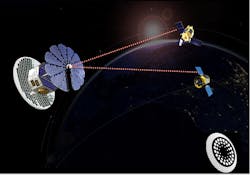Space-based wireless power grid operating via laser beams?
A new space infrastructure envisioned by Space Power, a UK company working with University of Surrey researchers to establish a wireless power grid in space, may soon enable an on-demand laser source as an “auxiliary sun” to beam solar power from satellites under solar illumination to small satellites orbiting closer to Earth during eclipse (see figure).
Satellites today rely on photovoltaic solar panels, which are semiconductor devices that convert sunlight into electrical energy. Some of this energy may be stored onboard on a battery so satellites can operate and can sustain themselves. The problem: this technology is designed to run exclusively from the power of the sun directly, even though satellites’ low Earth orbit (LEO) can take them into the Earth’s shadow.
Powered by space lasers
What does the new approach involve? A big piece of this work involves puzzling out which lasers will be most appropriate to transmit light over hundreds, if not thousands, of kilometers through space.
Laser light differs from sunlight in many aspects, but the most important difference in this case is it generates a very narrow band of wavelengths. “If we generate coherent light in a collimated form, it can be sent over large distances and remain a beam—and this is the key to using lasers to do this,” explains Stephen Sweeney, a physics professor at the University of Surrey leading the experimental studies. “The laser beam is essentially delivering energy to its target, the satellite. In turn, its solar panels convert this light back into electricity for the operations of the satellite or to charge its battery. A series of energy conversions through the system translate into satellites having energy when they need it.”
The researchers are also working to ensure the lasers they select and the light being generated are compatible with the photovoltaic solar cells on the satellites being targeted. Different types of solar panels exist, so they need to be able to accommodate this.
The group’s transmitter will use lasers that can direct high-power beams toward a target satellite, but “it also requires optics and tracking to locate and send energy selectively to target satellites,” Sweeney points out. “Essentially, the system starts with photovoltaic cells, which are a nice example of photonic technology themselves, and the electricity from it will be then converted into laser light for onward transmission.”
It's important to note that the laser light must be a particular wavelength; it can’t be a broadband white light like from the sun. “We’re working on the choice of wavelengths and what the delivery of light needs to look like from the laser, and how it may tie in with the type of solar panel onboard the satellites,” Sweeney adds.
Technology development is also underway on the laser side on pointing, optics for delivering it, communications between the satellites to know you’re pointing in the right direction, and ultimately satellite targeting. “There are quite a few different aspects of optical system design involved in this project,” Sweeney notes.
Weird space challenges, benefits
One space challenge is radiation, which can degrade solar cells and lasers, forcing researchers to place a heavy emphasis on reliability.
When a satellite is in the Earth’s shadow, its operating temperatures can be cryogenic (a couple hundred degrees below zero). “From a mechanical perspective, satellites can cope with this,” Sweeney says. “And an interesting thing about solar panels is that you actually get enhanced efficiency when they’re in the eclipse and cool down. It’s something we can take advantage of when we illuminate them with the laser while they’re in an eclipse; we can get higher power generation.”
Another challenge is that with the proliferation of satellites doing important work for humanity, LEO is becoming congested. The project’s work offers a big benefit: helping increase satellite efficiencies will prevent the need to continuously send more satellites up than the mission really needs, which will cut down on the amount of space junk.
Light detection and ranging (lidar) technology is also poised to play a role tracking satellites and space junk, while laser-based communication in space is becoming more important. “It’s becoming very clear that laser-based applications for space will be a big thing and, for the whole laser community, space is the next frontier to bring your technology,” Sweeney adds.
Space Power is aiming for a prototype launch in 2023, with commercial operations planned for 2025.
This project is part of the $10 million (7.4 million GBP) United Kingdom Space Research and Innovation Network for Technology (SPRINT) program.

Sally Cole Johnson | Editor in Chief
Sally Cole Johnson, Laser Focus World’s editor in chief, is a science and technology journalist who specializes in physics and semiconductors. She wrote for the American Institute of Physics for more than 15 years, complexity for the Santa Fe Institute, and theoretical physics and neuroscience for the Kavli Foundation.
